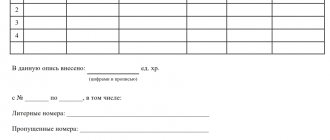Frequent causes of conflict situations between participants in a rental transaction are the use of the leased property for other purposes, an increase in fees by the lessor, and damage to property. To solve the first two problems, it is enough to disclose these issues in the contract. In order to avoid unpleasant situations with the safety of the property that the owner transfers to the tenant, it is necessary to carefully draw up an act of acceptance and transfer of non-residential premises under the lease agreement.
Files for download:
The lease agreement includes an act of acceptance and transfer of non-residential premises to the tenant, which is an integral annex. It includes: general information, a description of the external and internal condition of supporting structures, as well as property.
Instructions for filling out the act
- In the first part of the document, its name is written in the middle, as well as a short summary (in this case, “reception and transfer of non-residential premises”).
- The line just below indicates the city in which it is created and the date (in numbers or in words).
- Then enter the full name of the company (indicating the organizational and legal form of individual entrepreneur, LLC, CJSC, OJSC in abbreviation or in words) transferring the premises with the designation of the head (here usually written Director, General Director, or another employee authorized to sign these documents), and the document on the basis of which it operates (“Charter”, Regulations”, “Power of Attorney”, etc.) is also indicated
- Next, the same information about the second side of the process is entered into the act and the very fact of acceptance and transfer of non-residential premises is recorded.
- Then in the act you need to indicate the date of acceptance and transfer, the area of the transferred object (in numbers and in words), the address of its place of registration, briefly information about the main agreement (number, date of conclusion) and once again enter the names of the enterprises that entered into the agreement.
- Next, we enter the condition of the transferred non-residential premises .
If it is in the condition that corresponds to the contract concluded between the parties, then this should be indicated, but if it has any flaws or shortcomings (for example, lack of repairs, broken interior elements, etc.), then this must also be noted. recorded, and in a separate document, which should be drawn up as an appendix to this act.
If everything is fine, then you should further state that the receiving party has no comments or complaints about the condition of the transferred object.
In conclusion, the act must be certified by the signatures of representatives of both legal entities or authorized employees. The document can be stamped with seals, but it is not necessary.
Features of compilation
The document has its own special characteristics , which are worth paying attention to when signing it. Among these points are:
- The form must contain information about each of the parties signing the agreement. Information includes data such as last name, first name, patronymic, registration address and address of actual place of residence, telephone number, email, bank account. There must also be a signature and date of signing. This data is filled in on both sides.
- Signing this type of agreement is permissible for both individuals and legal entities . Moreover, individuals can enter into it among themselves, as well as with legal entities, which include both private entrepreneurs and legal organizations. If the contract is signed by a representative of a law firm - the director of the enterprise, in addition to the data indicated above, the contract must also indicate the position of the authorized person and his passport details, as well as permission according to which he has the right to represent this organization.
- The document contains information about the subject of its conclusion - the transfer of non-residential premises for use for a certain period for a certain fee. In addition to these general data, the contract contains data on the type of premises, its purpose according to expert assessment, and the total area.
The transfer and acceptance certificate contains detailed information about the technical condition of the property. The condition of ceilings, wall partitions, windows, walls, doors, and floors is described in detail here. In the event that the property is rented out not only as an area, but also contains furniture and other property, then a detailed inventory of the items and their condition must also be indicated in the act.
Both parties need to sign the documents. If one of the parties or both are private entrepreneurs or legal companies and work with a seal, its imprint must be on the document near the signature. One copy is kept by the lessor, the other by the tenant.
Sample act
Let's consider an example of filling out the clauses of the transfer deed of non-residential premises. This template is used when transferring to the tenant. When returning after termination of the rental agreement, use a similar form, which can be downloaded below. The form is divided into several components:
- This sample acceptance and transfer of premises is an annex to the contract, the number of which is written in the upper right corner. The name, city and date of compilation must be indicated.
- Next, fill in information about the representatives of the parties. For legal entities this will be the name of the organization, and for individuals we indicate the last name, first name and patronymic. Next, the full name of the founder or his authorized representative and a document confirming the authority (charter, certificate or passport of a citizen of the Russian Federation).
- Next, general information about the contract and the real estate is written down: name, area, location and cadastral number.
- The main point of the application is the condition of the rented non-residential premises at the time of transfer.
- An assessment (good or satisfactory) is given to the main load-bearing structures of the room: walls, floor, ceiling, windows. If any defects are found, they are described in the acceptance certificate. If necessary, the issue of eliminating detected defects is resolved, if possible. Indicates whether a complete or cosmetic repair is required.
- The property of non-residential premises, which includes furniture and equipment, should be listed. Different properties will have different contents. For example, for an office: office tables, chairs and computers; for a store: refrigeration equipment and shelving; for car service: tire fitting equipment and balancing stand; for the enterprise: extrusion line, overhead crane, etc. If the building is transferred empty, put a dash in this column and write: “there is no movable property.”
- Engineering systems are also listed: electricity supply, heat supply, water supply and sanitation, ventilation and air conditioning, video surveillance, alarm system, etc.
The number of copies of the acceptance certificate and lease agreements must correspond. The transfer of rights and obligations occurs when the document is signed by both parties. The application is drawn up on separate sheets, filed and stored together with the main agreement.
General information about the document
The conclusion occurs by agreement of both parties, who are referred to according to the agreement as the lessor and the lessee. The landlord is the owner of the property, the tenant is the person who accepts the premises for temporary use for a certain fee, as stated in the documents accompanying the transaction.
The terms of the agreement are such that the property is rented not only in accordance with the executed lease agreement, but also in accordance with the acceptance certificate. The deed is an integral part of the lease agreement. As a rule, it is drawn up in two forms - one remains with the owner of the premises, the other is with the tenant.
Is this document always needed or not?
If we consider the act drawn up in addition to the lease agreement, the date of signing will be considered the beginning of the lease period. Naturally, in such situations this act is mandatory. A document signed by both parties officially allows the receiving party to use the premises. It is accepted that immediately after signing the document, the parties exchange money and keys. The act is drawn up even in situations where the rental period lasts only a few days.
If the transfer document is an attachment to the purchase and sale agreement, it also serves as confirmation of the fulfillment of obligations.
When one of the parties avoids using this document in a transaction, the law regards this as unwillingness to fulfill the terms of a previously drawn up agreement. In addition, the signed act confirms that the seller and buyer have fulfilled their obligations, namely, handed over the keys and money.
Drawing up a deed of transfer can be safely called an integral stage of completing a transaction related to real estate. You need to understand that until the deed is signed, the lease or purchase and sale agreement is considered only a preliminary agreement.
It can also be assumed that the absence of a transfer document may lead to some difficulties. For example, the tenant does not bear financial responsibility for the real estate and has the right not to pay the previously agreed rent. The owner will not be able to make claims related to the deterioration of the technical condition of the premises.
Information to be provided
There is no strict and unambiguous answer to this question. Since the law does not regulate how the document will be drawn up . You can only indicate the main points. A well-written document must contain:
- Name and details of the agreement. The deed is always based on the main contract. It must contain references to the agreement in addition to which it was drawn up.
- Parties to the contract and basic information about them. The purchase and sale agreement contains complete information about the counterparties. This is not necessary in the act; only the names of the parties and their representatives are required.
- Description of the premises. It is necessary to clearly identify the object of the transaction. Provide accurate data:
- property location address;
its exact area;
- floor;
- cadastral number.
- condition of the façade;
- quality of flooring, walls, ceiling;
- availability of communications;
- condition of the electrical wiring.
- List of shortcomings. It would be advisable to record shortcomings, if any. This will facilitate the resolution of possible disputes that arise after drawing up all the documents.
Next, the participants in the transaction can indicate the data that they themselves consider important. Typically this is information recording the state of the premises/s at the time of transfer:
General design requirements
When drawing up a transfer deed, you must adhere to certain rules:
- The number of copies of the document must correspond to the number of parties between whom the transaction is concluded;
- Confirming their agreement, the parties are required to affix signatures identical to the autographs in the contract. Authorized persons can also sign a document if there is a corresponding power of attorney;
- Information about the premises is indicated as completely and clearly as possible. If any malfunctions or technical problems are found, they are recorded in the report;
- Once the parties have signed the document, the receiving party bears full responsibility for the premises.
In general, there are not so many requirements for drawing up this act. Here you just need to adhere to the rules for preparing documents of this kind.
Unified form OS-1a (form)
The unified form OS-1a “Act of acceptance and transfer of a building (structure)” was approved by Decree of the State Statistics Committee of the Russian Federation dated January 21, 2003 No. 7.
You can download its form on our website.
Let us remind you that the use of unified forms is now optional. If you wish, you can develop and approve the form of this act yourself. Read more about this in “Primary document: requirements for the form and the consequences of its violation .
The main subtleties of the act of acceptance and transfer of non-residential premises
There is no single approved template for writing such an act, so it can be written in free form or using a special template. The act is drawn up in two copies - one for each of the interested parties. It can be drawn up on a regular A4 sheet in handwritten or printed form.
The document must indicate the names of the legal entities involved in the agreement, as well as the individual characteristics of the space being sold or leased. These include: cadastral number, area of the premises, address, technical condition. Here you can also include the availability of utilities and other services, such as gas, heating, water, electricity, Internet, elevator, telephone, security, etc. By agreement of the parties, a cadastral passport or other papers (drawings, extracts, diagrams) for the premises can be attached to this document.







